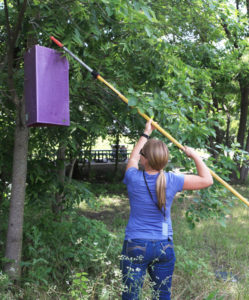Emerald Ash Borer Texas Update
Emerald ash borer makes a move

Texas A&M Forest Service has conducted surveys for emerald ash borer for several years. Large purple sticky traps are placed in trees to attract and entrap the beetles.
Ever since the dreaded emerald ash borer (EAB) showed up in Arkansas and Louisiana, tree lovers have braced themselves for its inevitable arrival in Texas. Then, in May 2016, the insect was discovered in a single surveillance trap near Caddo Lake in Harrison County in east Texas. In 2017 all was quiet, with no officially reported sightings; but this summer the beetle has been found in possibly three new counties.
What is EAB?
The EAB is a small but powerful beetle pest–an enemy of ash trees. Adult beetles feed on ash leaves and deposit eggs on the bark of their ash hosts. The eggs hatch and the tiny larvae penetrate the bark to feed on water conducting tissues inside the tree. Within 2-3 years the tree loses the ability to conduct sap, and succumbs to the infestation. Within 10 years of initial invasion all untreated ash trees in an invaded area are expected to die.
When it comes to ecological destruction, the EAB is practically without peer among exotic insect pests. In areas where established, it wipes out virtually all species of ash trees in the genus Fraxinus. In 2017 scientists at the International Union for the Conservation of Nature declared five major species of ash trees in the U.S. on the brink of extinction due to the borer.
A few years ago, I had the opportunity to travel to one of the hardest hit states to view EAB’s destructive power. Along the highways of Indiana, dead ash trees were obvious. They lined roadsides and peppered city parks and yards. Ash is a less dominant tree in Texas. But should EAB spread here, many beautiful ash shade trees in yards, streets and parks would be lost.
According to Texas A&M Forest Service entomologist Allen Smith, EAB showed up in two new Texas counties this year. As of last week, Marion and Cass counties near the northeastern corner of Texas have detected EAB in traps placed out to monitor for the beetle. In addition, 6-7 additional traps in Harrison county (the initial site of entry into Texas) have detected the beetle.
iNaturalist report
The emerald ash borer adult is relatively easy to identify by its size, shape and metallic green color.
This week Texas Wildlife biologist, Sam Kieschnick, was reviewing pictures posted on iNaturalist, when a beetle from Tarrant County caught his eye. Submitted last summer by 10-year-old naturalist, Sam Hunt, the picture appears to show an emerald ash borer found in Tarrant County, just north of the Fort Worth Nature Center. Links to the picture were also viewed by biology student from University of Wisconsin, Alex Harman, and then by beetle expert, Dr. Henry Hespenheide, who both concluded it was likely EAB.
Unfortunately the beetle was not preserved for positive ID, so the Texas Forest Service will attempt to verify the presence of the beetle in Tarrant County. If confirmed, this will be the deepest find yet of the beetle in Texas, and one of the farthest west occurrences of EAB. It will also signal a need for any valuable ash trees within 15 miles of the sighting to be proactively treated, according to standard control recommendations.
The beetle spreads naturally from tree to tree, but large jumps in distribution are thought to occur only with the help of man. Foresters caution the public to never move hardwood firewood out of an EAB-infested county to avoid helping the beetle spread. Firewood cut from infested trees is likely to harbor live beetles that later emerge and infest nearby ash trees.
For more information on EAB, it’s biology and control, go to http://www.emeraldashborer.info/ Insect Updates will keep you informed about possible spread to the Dallas/Fort Worth area.
The post Emerald ash borer makes a move appeared first on Insects in the City.
-
March 2, 2024
Firefighters rush to subdue deadly Panhandle wildfire before dangerous conditions return Saturday -
February 14, 2024
Texas Workforce Commission presents Texas Conference for Employers -
February 1, 2023
Are your trees damaged by the ice storm? -
July 28, 2022
Another benefit of Texas trees: Cooler temperatures -
February 25, 2022
Time to Plant Trees in Texas -
January 27, 2022
Treemergency: Mulch Volcanos are Erupting in Landscapes! -
December 21, 2021
Cedar fever season in Texas -
November 9, 2021
Texans celebrate 2021 Arbor Day in Weatherford, Texas – and beyond -
June 24, 2021
41st Texas Tree Conference, Academy, Trade Show and Tree Schools -
February 17, 2021
Texas Sized Winter Storms Can Damage Trees


